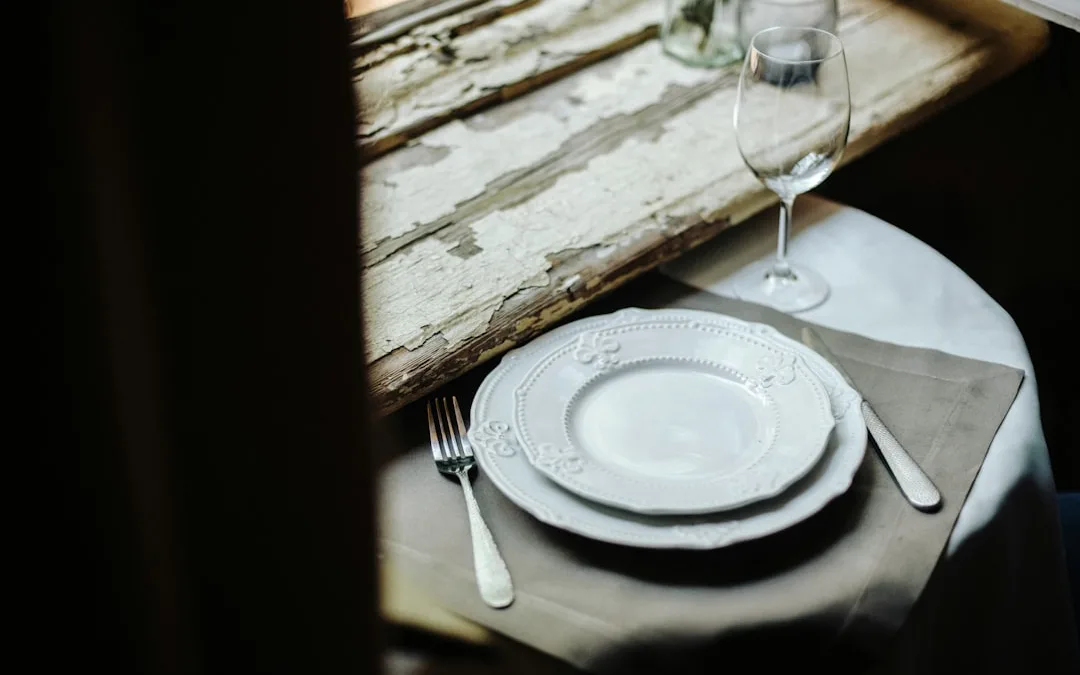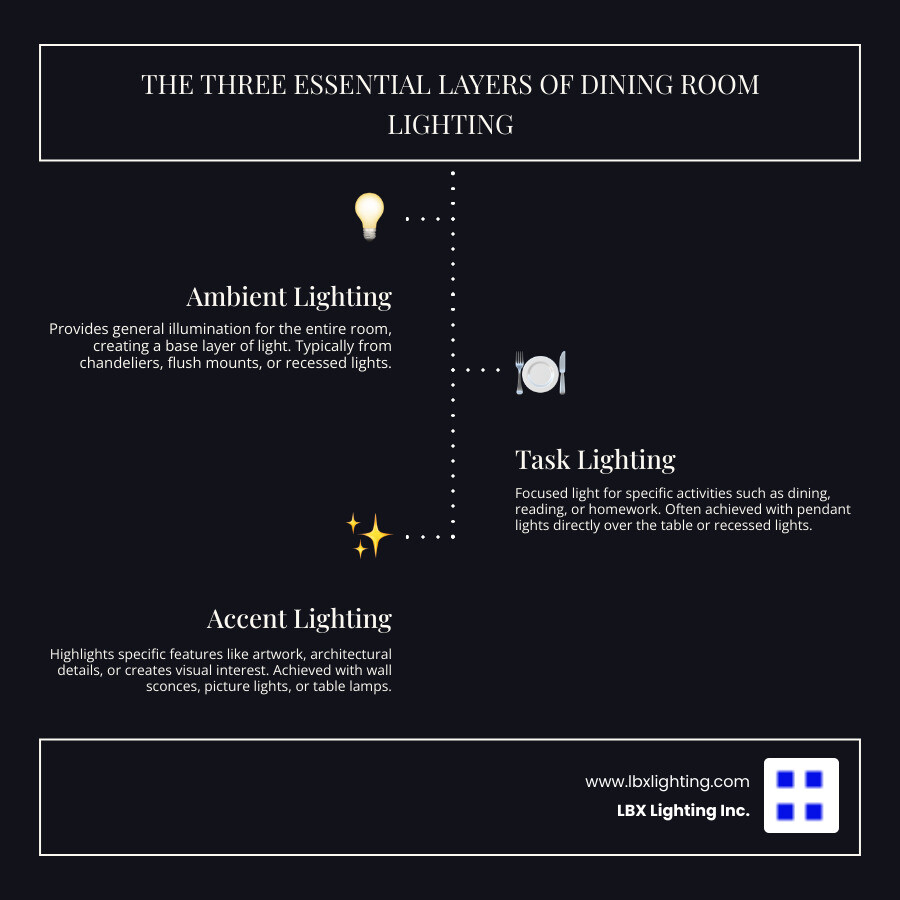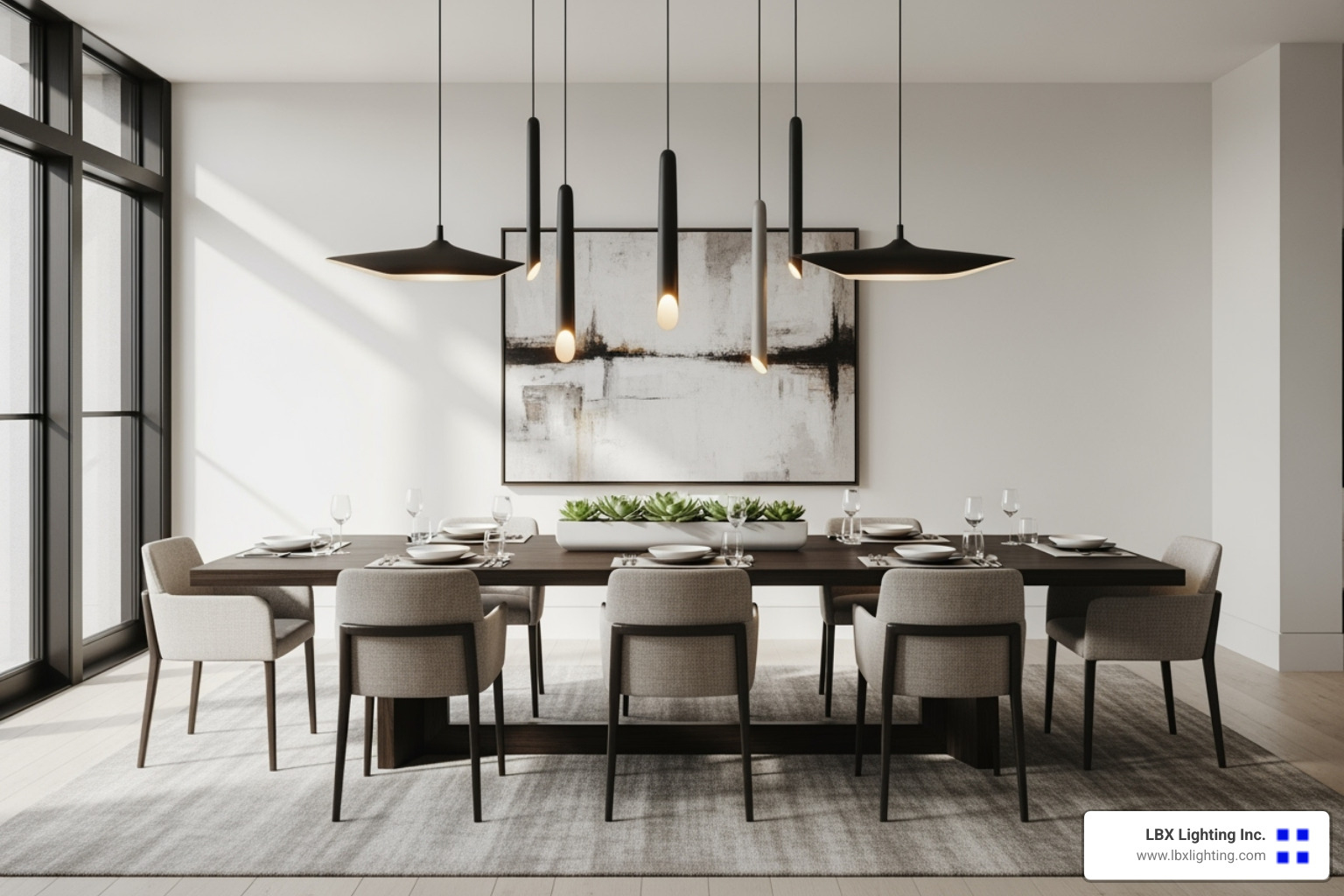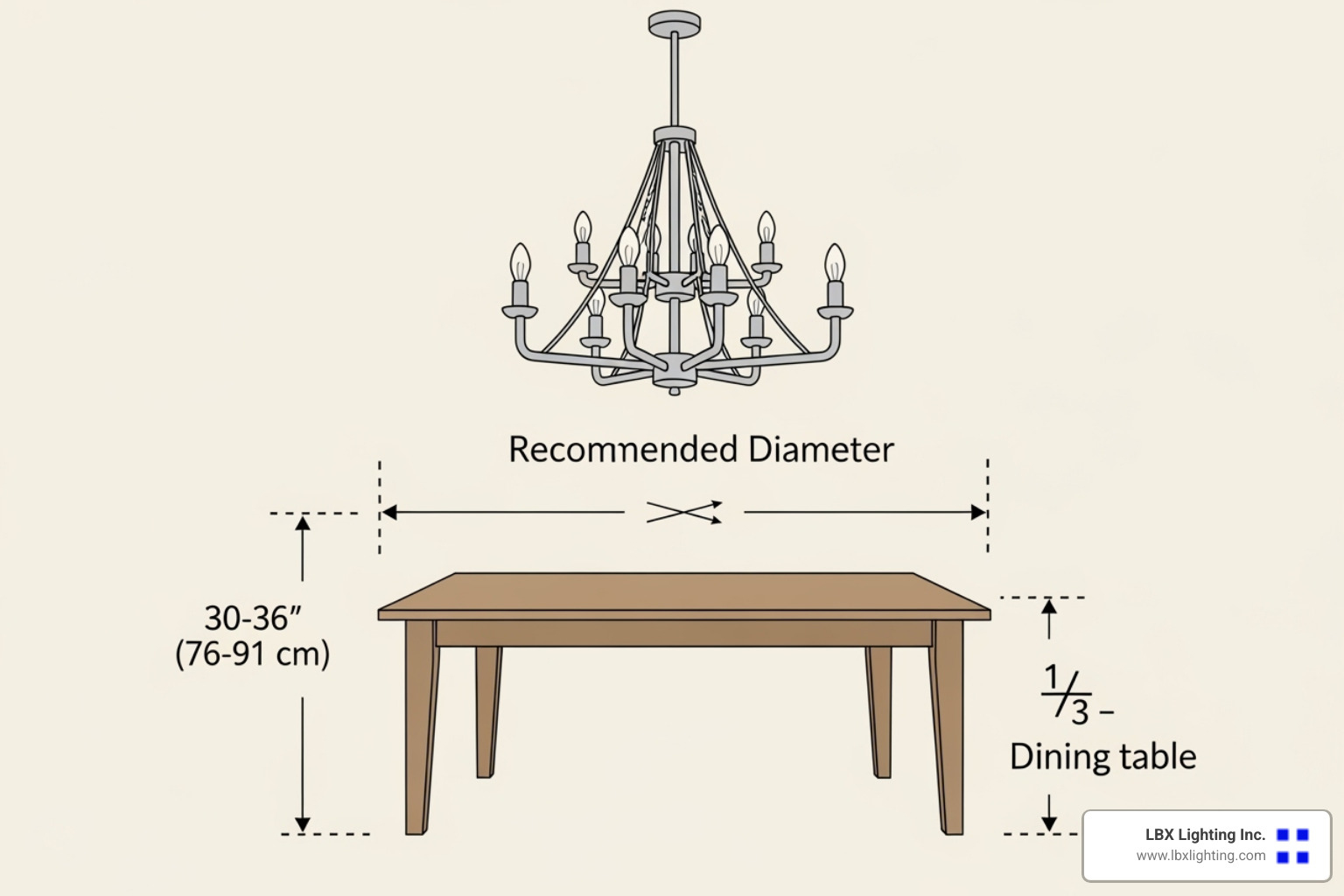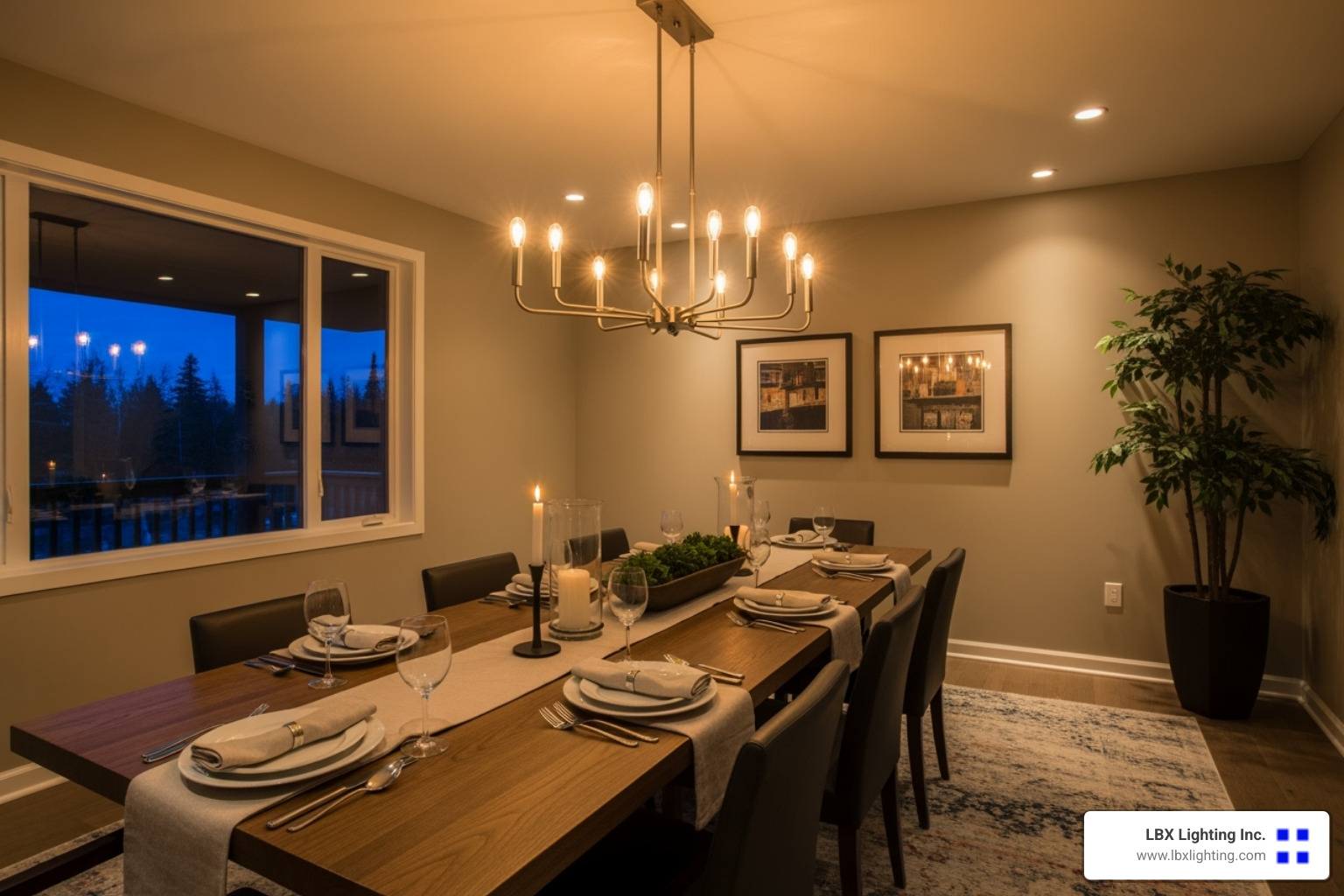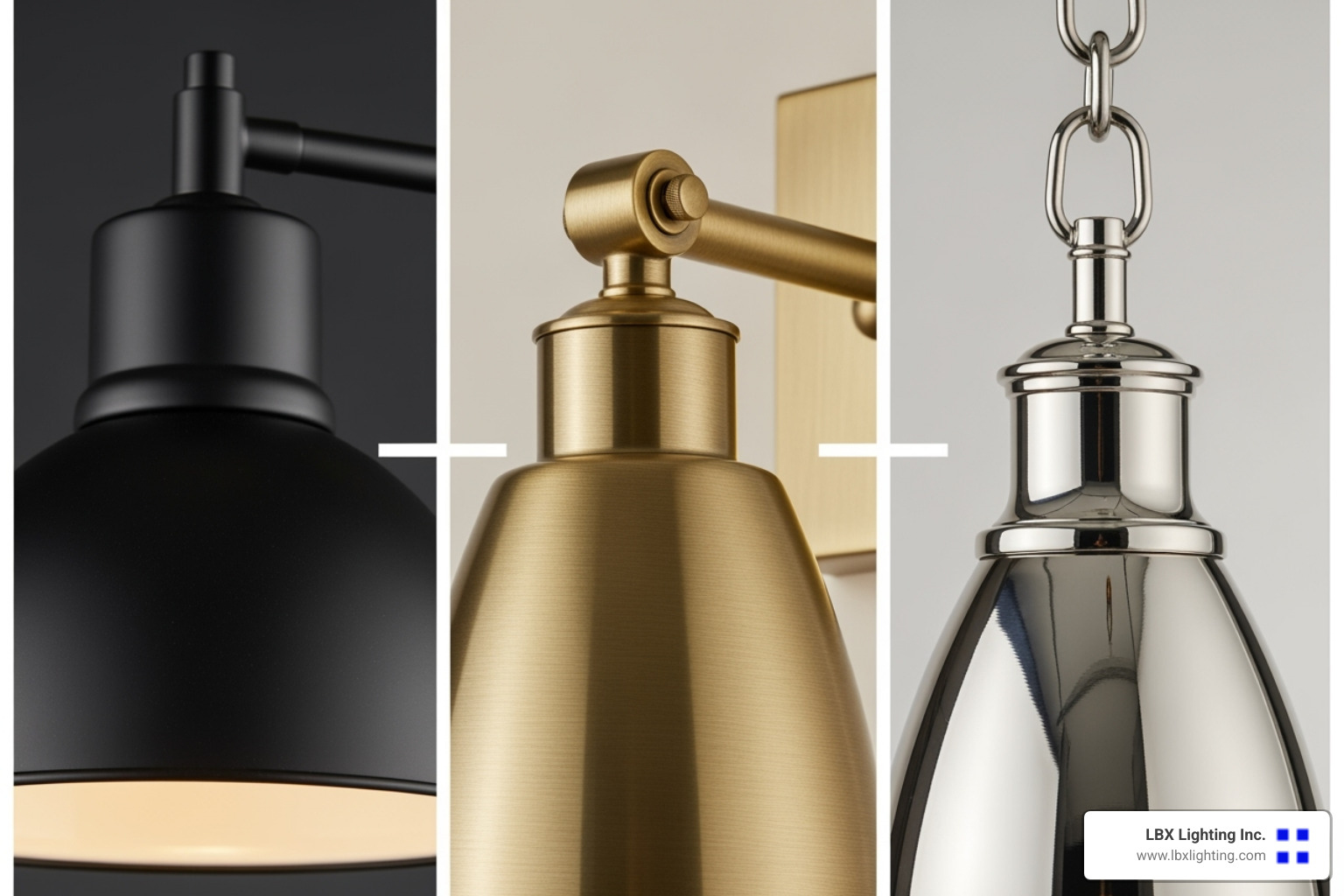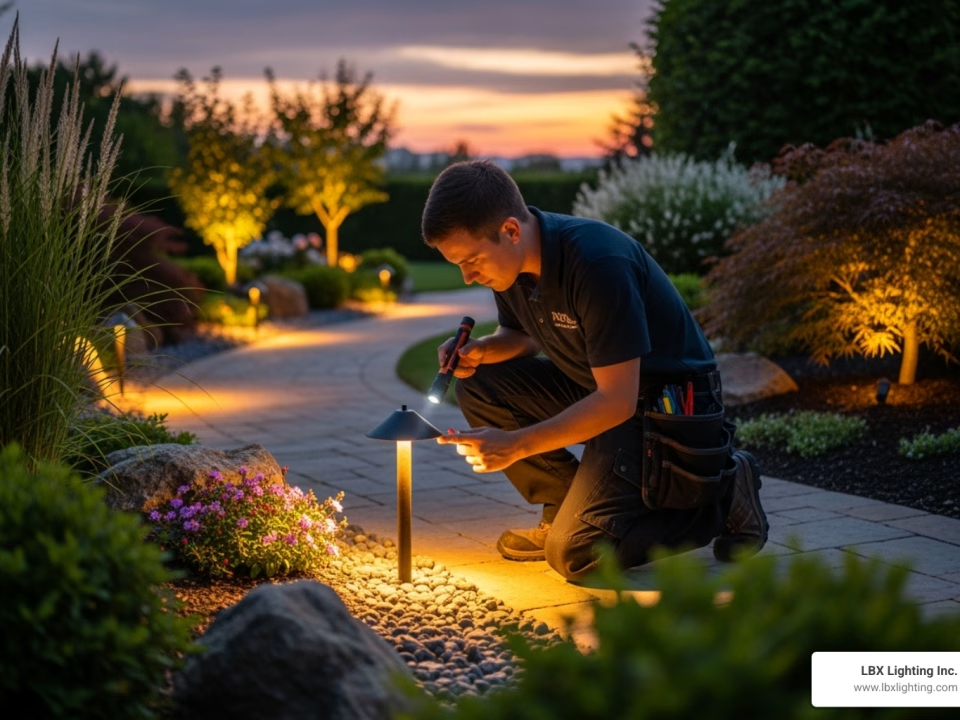
Unique Dining Room Lights That’ll Make Your Guests Jealous
August 5, 2025
Top Dining Ceiling Lights Designs for Every Style
August 7, 2025Why Dining Room Lighting Design Matters More Than You Think
Dining room lighting design is the key to creating a space where memorable meals and meaningful conversations happen. The right lighting transforms your dining room from a simple eating area into the heart of your home, setting the mood for everything from family dinners to holiday celebrations.
Quick Guide to Dining Room Lighting Design:
- Layer your lighting – Combine ambient (general), task (functional), and accent (decorative) lighting.
- Size your fixture correctly – A chandelier’s diameter should be 1/2 to 2/3 the width of your dining table.
- Hang at the proper height – Aim for 30-36 inches above the table surface.
- Match shapes – Use round fixtures for round tables and linear fixtures for rectangular ones.
- Use dimmers – Essential for adjusting the mood from bright task lighting to intimate dining.
- Aim for 3,000-6,000 total lumens – Use a warm color temperature (2,700K-3,000K) for a cozy ambiance.
The biggest challenge? Most people rely on a single overhead light, missing the magic that layered lighting provides. A well-lit dining room needs to be versatile, ready for homework one moment and a dinner party the next.
I’m Michael Eftekhar, and for over 30 years, I’ve helped Houston-area homeowners and designers create stunning spaces through expert dining room lighting design. At LBX Lighting, we know the right choices can completely transform how a family enjoys their dining space.
Explore more about Dining room lighting design:
The Foundation: Choosing the Right Fixture Type
Picking your main light fixture is like choosing the star of your dining room show. This centerpiece sets the mood and style, supporting your entire dining room lighting design. At LBX Lighting, we’ve helped countless Houston families find their perfect match from our extensive collection of Light Fixtures for Dining Room and Residential Lighting Fixtures.
Chandeliers: The Classic Centerpiece
For a dramatic statement, nothing beats a chandelier. It’s the jewelry of your dining room, instantly drawing the eye upward and adding a touch of elegance. Chandeliers work beautifully as focal points, with styles ranging from traditional crystal designs to modern fixtures with clean, geometric lines. While they require adequate space and can be intricate to clean, a well-chosen chandelier transforms the dining experience.
See what catches your eye in our Modern Chandelier for Dining Room and Crystal Chandelier Pendant Light collections.
Pendants: Versatile and Stylish
Pendants are the stylish, adaptable choice for modern dining rooms. These hanging fixtures bring a contemporary look that’s both practical and beautiful. Pendants excel at task lighting, focusing light exactly where you need it. Linear pendants suit rectangular tables, while cluster pendants add interest over round ones. The main consideration is hanging them at a height that doesn’t obstruct views across the table. Their customizability in height, size, and grouping makes them a favorite for custom designs.
Browse our Stylish Pendant Lights and Pendant Light Fixtures to find your favorites.
Flush Mounts and Wall Sconces
For rooms with low ceilings or for creating layered lighting, flush mounts and wall sconces are the unsung heroes. Flush mounts attach directly to the ceiling, providing general illumination without taking up headroom. They are a perfect space-saving solution. Wall sconces add soft ambient light and serve as beautiful accent lighting, often flanking a buffet or artwork to create a warm, inviting perimeter glow. While not the main showstopper, they are the essential supporting cast that makes a lighting design feel complete and are often a great value.
Mastering the Rules of Scale, Size, and Placement
Getting the size and placement right is where dining room lighting design truly succeeds or fails. A beautiful fixture can look wrong if it’s the wrong size or hung at the wrong height. Fortunately, a few simple rules make it easy to get it right.
How to Choose the Right Size and Scale
When in doubt, bigger is usually better for dining room lighting. A common mistake is choosing a fixture that looks lost above the table. Here’s the formula we use:
- Your fixture’s diameter should be one-half to two-thirds the width of your dining table. For a 48-inch wide table, look for a fixture between 24 and 32 inches across.
- For round tables, make your chandelier 12 inches smaller than the table’s diameter. A 54-inch round table pairs perfectly with a 42-inch chandelier.
Consider your room’s size as well. A grand room with high ceilings can handle a fixture at the upper end of the size range to ensure it feels balanced.
Need more guidance? See our How to Choose the Perfect Dining Room Lighting: A Complete Guide.
Perfecting the Hanging Height
This is the most common mistake we see. A fixture hung at the wrong height can disrupt the room’s entire aesthetic.
- The golden rule is 30 to 36 inches above your table surface. This sweet spot ensures the fixture is a focal point without blocking conversation.
- For ceilings over 8 feet high, you can add a few extra inches to the hanging height to maintain proportion with the room’s vertical space.
For low ceilings, stick closer to the 36-inch mark or consider a flush mount. The goal is a balance where the light is functional, proportional, and allows for comfortable interaction.
For more, explore How High Should a Chandelier Be Above Table and How High to Hang Chandelier Over Dining Table.
Matching Fixtures to Your Table Shape
A simple principle for a polished look is to echo your table’s shape with your fixture.
- Round tables pair best with round chandeliers or globe pendants.
- Rectangular and oval tables work well with long linear fixtures or multiple pendants lined up to ensure even light distribution.
- Square tables are versatile but look best with a single, centered fixture like a chandelier or a pendant cluster for symmetry.
This creates visual harmony and ensures light reaches every corner of the table. Browse our Modern Chandelier for Dining Table collection to see how different shapes work with various table styles.
The Art of Layered Lighting for a Functional Dining Room Lighting Design
Here’s the truth about dining room lighting design: one overhead light is never enough. To create a space that adapts from homework sessions to romantic dinners, you must think in layers. Layered lighting provides the flexibility to shift from bright and functional to soft and intimate with the flip of a switch.
The Three Essential Layers of Light
Think of lighting in three distinct layers that work together to create depth, dimension, and flexibility in your dining room.
- Ambient Lighting: This is your general, overall illumination, the foundation of your lighting plan. It typically comes from your main chandelier, pendant, or flush mount fixture.
- Task Lighting: This is focused light for specific activities like eating, reading, or homework. Pendants and well-placed recessed lights are perfect for this.
- Accent Lighting: This is the decorative layer that adds warmth and personality. Wall sconces, buffet lamps, and picture lights highlight features and create a magical atmosphere.
For help creating a comprehensive plan, see our guides: How To Develop A Lighting Plan and Lighting Your Home Is Easy When You Know How.
Planning and Placing Recessed Lighting
Recessed lighting is the reliable supporting actor in your dining room lighting design. These fixtures provide crucial, shadow-free illumination. The key is beam spread and strategic placement. We recommend fixtures with a 36-degree beam spread for even coverage over dining tables. To get the spacing right, take your table width in inches and divide by four. A 72-inch wide table would mean placing the first light 18 inches from the edge, with subsequent lights spaced 36 inches apart. This ensures the light beams overlap slightly above the table for seamless illumination.
Dive deeper with our guide: How to Correctly Light Your Dining Room Table.
Lighting for a Multi-Functional Space
Your dining room table is a hardworking surface. For homework and crafts, you need bright, focused task lighting from your main fixture and recessed lights. For dinner parties, that bright light can feel harsh. This is when you dim the main lights and let accent lighting, like wall sconces and candles, create a warm, intimate glow. The game-changer that makes this possible is the dimmer switch. Dimmers are absolutely essential on every light fixture in your dining room, allowing you to transition seamlessly from functional to atmospheric lighting.
Setting the Mood: Bulbs, Finishes, and Styles
Beyond placement, the specific bulbs, finishes, and styles you choose are what bring your personality to your dining room lighting design. These are the finishing touches that tie the entire room together.
Choosing the Best Bulbs for Ambiance and Function
The right bulb can make or break your dining room’s atmosphere. Pay attention to both brightness (lumens) and the warmth of the light (Kelvin).
- Lumens: Aim for a total of 3,000 to 6,000 lumens for the room. This range, controlled by dimmers, gives you bright light for tasks and the ability to dim down for cozy meals.
- Color Temperature: Stick to the 2,700K to 3,000K range on the Kelvin scale. This produces a warm, inviting glow that is flattering to skin tones and creates a relaxing atmosphere.
Dimmers are non-negotiable for this level of control. Always choose dimmer-compatible bulbs, and we highly recommend LEDs for their energy efficiency and long lifespan.
Learn more about how Good Lighting Can Affect Ambiance and Why Good Lighting Is Important In Your Home And For Your Mood.
The Impact of Finishes and Popular Dining Room Lighting Design Styles
The finish and style of your fixture set the tone for the entire space. Popular finishes include:
- Black: Bold, modern, and creates striking contrast.
- Brass: Adds warmth, elegance, and a touch of vintage or modern farmhouse charm.
- Nickel: A versatile contemporary feel, from soft brushed to sleek polished.
- Bronze: Brings warmth and tradition, fitting for rustic or farmhouse styles.
Popular design styles for your dining room lighting design include:
- Modern: Clean lines, geometric shapes, and an unfussy aesthetic.
- Farmhouse: Combines rustic charm with neutral colors and natural materials.
- Industrial: Features raw materials like metal and exposed bulbs for an edgy, urban feel.
- Boho: Plays with organic materials, texture, and free-spirited shapes.
- Glam: Uses high-shine materials like polished metal and crystal for a luxurious, dazzling effect.
- Organic & Sculptural: A major trend using natural textures and fixtures that double as art.
Incorporating Smart Lighting Technology
For ultimate convenience, smart lighting is a game-changer. With smart bulbs and switches, you can control your lights wirelessly via voice or app control. Imagine dimming the lights for dinner with a simple command to Alexa or Google Home. You can also use scheduling to automate your lighting or create mood-setting scenes, like a “dinner party” setting that adjusts all your lights to the perfect levels with a single tap.
Frequently Asked Questions about Dining Room Lighting
After 30 years of helping Houston homeowners with their dining room lighting design, I’ve heard the same questions many times. Here are the answers to the most common concerns we address at LBX Lighting.
What is the most common mistake in dining room lighting?
The biggest mistake is choosing a fixture that is too small for the space. Scale is everything. A light that’s too small will look underwhelming and fail to anchor the room. The second most common error is relying on only one light source. A truly functional dining room requires layers of light (ambient, task, and accent) to accommodate different activities.
How many lumens do I need for a dining room?
A good rule of thumb is 30-40 lumens per square foot. For most dining rooms, this means a total of 3,000 to 6,000 lumens for the entire space. The key is to have this full range available and control it with dimmers. This allows you to have bright light for tasks like homework and a soft, ambient glow for intimate dinners.
Can I put a rectangular chandelier over a round table?
I strongly advise against this. While there are no official rules, a rectangular fixture over a round table creates a visual clash that feels unbalanced. The best approach is to echo your table’s shape with your fixture. A round table calls for a round or organically shaped chandelier. This creates a sense of harmony and makes the design feel intentional and professionally curated.
Conclusion
Your dining room lighting design journey is about creating a space that is both beautiful and functional. By focusing on a few key principles, you can transform your dining room into the warm, welcoming heart of your home.
Remember the essentials: Layer your lighting for flexibility, get the scale right so your fixture is perfectly proportioned, and install dimmers to control the mood for any occasion. Your dining room is where life’s best moments happen, from birthday celebrations to quiet family meals. The right lighting doesn’t just illuminate these moments—it improves them.
A well-designed lighting plan turns your dining room into a versatile space that adapts from bright and practical to soft and atmospheric. It’s a change that can completely redefine how you use and enjoy the room.
The dining room truly is the heart of the home, and thoughtful lighting helps you make the most of every moment. Whether you prefer the elegance of a chandelier or the modern look of pendants, choose fixtures that reflect your style and support the way you live.
For expert advice and a wide selection of Residential Lighting Solutions in the Houston area, the team at LBX Lighting Inc. can help you create the perfect lighting plan. We pride ourselves on exceptional customer service, expert staff, and competitive pricing. Explore our extensive collection of Light Fixtures for Dining Room to find the perfect centerpiece for your home.


